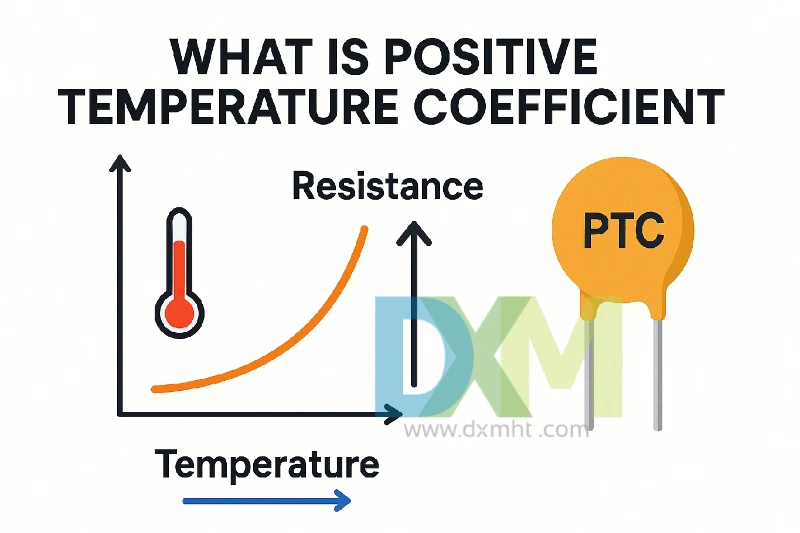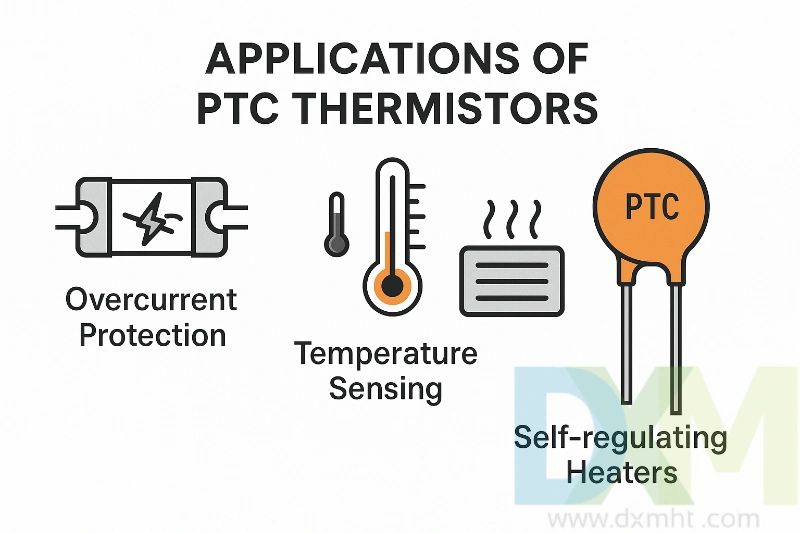What Is Positive Temperature Coefficient? Expert Guide on PTC Thermistors
Explore what is positive temperature coefficient and the science behind PTC thermistors. This comprehensive guide covers technical insights and industry applications to help professionals understand and leverage PTC technology effectively.
- Understanding What Is Positive Temperature Coefficient
- The Science Behind What Is Positive Temperature Coefficient
- Types of PTC Thermistors and Material Composition
- Applications of PTC Thermistors
- Benefits of Positive Temperature Coefficient (PTC) Thermistors
- What is Positive Temperature Coefficient?
- What is Positive Temperature Coefficient (PTC) Thermistors?
- Key Benefits of PTC Thermistor
- Reliability
- Safety
- Efficiency
- Cost-Effectiveness
- Why Choose PTC Thermistors from a Reputable Manufacturer?
- How to Choose the Right PTC Thermistor
- Why Partner with DXM for Quality PTC Thermistors
- Conclusion: Harnessing What is Positive Temperature Coefficient?
- Take Action:
What Is Positive Temperature Coefficient? A Comprehensive Guide to PTC Thermistors In the field of thermistors, understanding what is positive temperature coefficient (PTC) and how a positive temperature coefficient impacts device behavior is essential for electronics professionals. As leading experts and manufacturers like DXM have demonstrated for over 29 years, PTC thermistors play a pivotal role in modern electronics.
This article delves into the science and application of positive temperature coefficient materials, enabling engineers and specialists to make informed decisions that optimize reliability and performance in their designs.
Understanding What Is Positive Temperature Coefficient
The term positive temperature coefficient refers to a physical property of materials and components whose electrical resistance increases as temperature rises. This behavior is opposite to the more commonly known negative temperature coefficient (NTC), where resistance decreases with rising temperature.
PTC thermistors utilize this principle by incorporating materials whose resistivity changes predictably with heat. This property allows PTC thermistors to be effective in temperature sensing, current limiting, and self-regulating heating applications.

The Science Behind What Is Positive Temperature Coefficient
In a PTC thermistor, the conduction mechanism is dominated by the material’s crystal lattice and the movement of charge carriers. As temperature increases, lattice vibrations intensify, scattering electrons more and thereby increasing resistance. This increase occurs exponentially beyond a threshold temperature, commonly referred to as the Curie point in ceramic PTC thermistors.
This sharp resistance rise is invaluable for safety and control applications, making PTC thermistors indispensable components in circuits requiring overcurrent protection or controlled heating.
Types of PTC Thermistors and Material Composition
PTC thermistors are generally classified into two categories:
1. Ceramic PTC Thermistor: This relies on ferroelectric ceramics. The resistance remains low and steady until a specific temperature, then it increases sharply.
2. Polymeric PTC Thermistors: Composed of conductive polymers mixed with carbon-based fillers, these devices exhibit more gradual resistance changes, useful in flexible or customized applications.
At DXM, we focus primarily on ceramic PTC thermistor, renowned for stability, quick thermal response, and repeatable characteristics preferred across industrial, automotive, and consumer electronics.
Applications of PTC Thermistors
Understanding what is positive temperature coefficient extends beyond theory when applied in real-world scenarios. PTC thermistors serve multiple critical roles, including: - Overcurrent Protection: PTC thermistors acts as resettable fuses, rising resistance under electrical overload to protect circuits from damage.
- Temperature Sensing: Their predictable resistance rise with temperature makes them ideal sensors in heating systems and temperature monitors.
- Self-regulating Heaters: PTC elements can maintain a steady temperature by increasing resistance as the temperature rises, preventing overheating. In automotive electronics, consumer devices, power electronics, and telecommunications, the integration of PTC thermistors enhances safety and performance.
DXM’s high-quality thermistors are designed to meet these strict standards and diverse operating environments.

Benefits of Positive Temperature Coefficient (PTC) Thermistors
What is Positive Temperature Coefficient?
PTC thermistor is device whose resistance increases with temperature. This component is widely used in circuits requiring self-regulation, current limiting, and safety features.
What is Positive Temperature Coefficient (PTC) Thermistors?
PTC thermistors are temperature-sensitive resistors that increase resistance with rising temperature. Their ability to self-regulate makes them crucial in various applications, from safety to energy efficiency.
Key Benefits of PTC Thermistor
Reliability
PTC thermistor is highly reliable due to its stable resistance properties. It maintains performance over multiple thermal cycles, reducing the likelihood of failure in long-term use.
Safety
One of the main advantages of PTC thermistor is its automatic current-limiting feature. This capability makes it ideal for safety-critical applications, removing the need for manual adjustments or replacements.
Efficiency
In self-regulating systems, PTC thermistor helps reduce energy consumption. By maintaining optimal temperature control without external regulation, it enhances energy efficiency and minimizes wastage.
Cost-Effectiveness
PTC thermistor offers excellent return on investment (ROI). Its long lifespan and minimal maintenance make it a cost-effective solution for applications requiring frequent thermal cycling.
Why Choose PTC Thermistors from a Reputable Manufacturer?
Choosing a high-quality PTC thermistor from a reputable manufacturer, such as DXM, ensures optimal performance and dependability. With ISO 9001:2008 certification, DXM guarantees that each device meets the highest standards. Their ongoing research and development ensure that customers receive the most advanced, reliable products available.
By selecting the best PTC thermistor, you invest in quality and long-term reliability.
How to Choose the Right PTC Thermistor
When selecting PTC thermistor for your application, consider:
- Resistance Range: Baseline resistance at room temperature.
- Switching Temperature: The temperature point where resistance increases sharply.
- Application Environment: Voltage, current, and mechanical stresses.
- Physical Form: Disk, bead, or chip format based on installation needs.
Our team at DXM offers customizable options tailored to your precise project requirements, supporting seamless integration into product design.
Why Partner with DXM for Quality PTC Thermistors
DXM is recognized as a top-tier manufacturer with over 29 years of expertise. Our portfolio includes PTC thermistor, NTC thermistor, varistor, and temperature sensor tailored for automotive electronics, home appliances, telecommunications, and more.
With robust R&D capabilities and ISO certification, we ensure product reliability, innovative performance, and competitive advantage for your projects. Choosing DXM means partnering with a trusted supplier that continually adapts to emerging market needs and technological advancements.
Conclusion: Harnessing What is Positive Temperature Coefficient?
In summary, what is positive temperature coefficient and its application through PTC thermistor is a cornerstone concept in electronic component design. From current protection to temperature sensing, understanding and utilizing PTC thermistors unlock opportunities for safer, more efficient, and smarter products.
We encourage professionals in the thermistor industry to explore DXM’s product line for dependable PTC thermistors that elevate your designs. By integrating positive temperature coefficient technology, you ensure superior device performance and compliance with the latest industry standards.
Take Action:
Discover the advantages of high-quality positive temperature coefficient thermistors with DXM. Visit our website to explore product specifications, request samples, and consult with our engineers to optimize your solutions with precision and reliability. Harness the science of PTC technology to future-proof your electronics today!
© 2025 DXM Blog. All rights reserved.
Author: Ivan Huang
Recommended for you

Unlocking the 103 Capacitor: An Essential Guide for Professionals

Where Can I Buy Resistors? Your Expert Sourcing Guide

How to Find Impedance of a Capacitor: Guide for Professionals

how to calibrate rtd pt100?

Capacitor 104 Value: Essential Guide for Electronics Professionals

Positive Temperature Coefficient Heater: An Essential Guide of PTC Heater
Price and Payment
Payment Terms
There are a number of different payment methods that can be used when you deal with us. Two are mostly used: T/T payment in advance for small values and irrevocable L/C at sight for large values.
Logistics
How to track my order?
You can track your order through our official website or the order number provided and learn about the logistics status and delivery progress of your order at any time.
Can I change my shipping address?
Yes, you can contact our customer service team to modify the delivery address before order confirmation to ensure that the order can be accurately delivered to the address you specify.
How long does logistics delivery take?
Shipping times depend on your location and the shipping method you choose. Generally speaking, international shipping can take anywhere from a few weeks to a few months.
Customized Services
Custom-made sample/order
SHENZHEN DXM TECHNOLOGY CO., LTD. are structured by high-tech talents from famous university
in China and accompanied with a batch of ceramic-sensitive components experts and technology
specialist, have powerful R&D and technology capabilities.DXM is one of a few manufacturers
master core production technology of ceramic-sensitive components in the world.
Samples and orders can be custom-made per customer’s requirements, as below:
1. Application environment of product
2. Required specifications or technical parameters
3. Reference sample
4. Reference drawing
You may also like

WMZ12A 75S PTC Thermistors for Over-Current and Over-Load Protection

PTC Thermistors for Ballast Electronic and Energy Saving Lighting Intelligent Preheat Start MZ12 | DXM

Termistor PTC Thermistors MZ21 Series: Reliable Protection for Telecom Main Distribution Frame

PTC Electric Thermistors for telecom apparatus circuit protection (MZ23 series)

PTC Electronics MZ31 Series MZ8 Type: Reliable Overcurrent and Overload Protection Solutions

PT1000 Temperature Sensor: DXM Precision Platinum RTD Solutions

KTY83-110 Sensor with Silicon Glass Thermistor

Bracket Type NTC Thermal Sensor MF52X for Precise Temperature Measurement
Get in Touch
Discover premium thermistors, sensors, and resistors tailored to your needs.Our dedicated team of experts is available to assist with product selection, technical queries, and after-sales service. Contact us for custom solutions and experience exceptional customer support.
© 2025 DXM | All Rights Reserved.

 Scan QR Code
Scan QR Code
Scan QR Code
Whatsapp: +8618927361658
Shenzhen DXM Technology Co., Ltd.
DXM PTCNTC
Shenzhen DXM Technology Co., Ltd